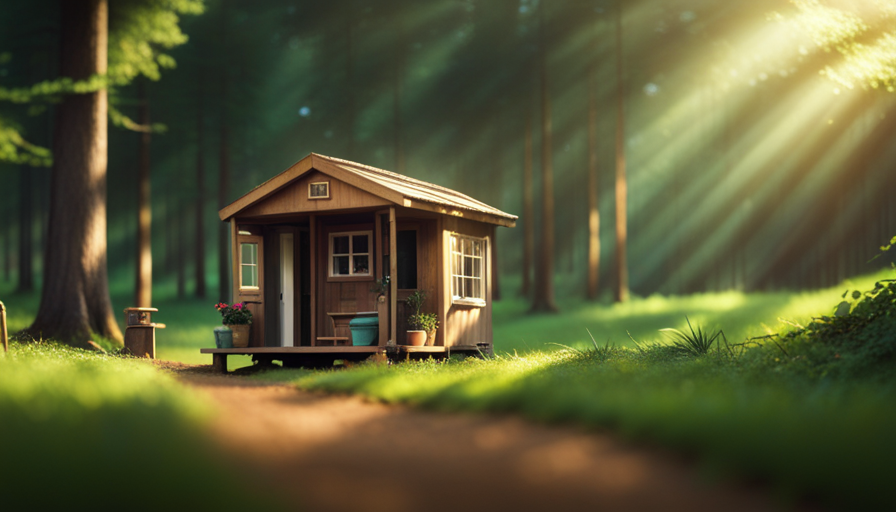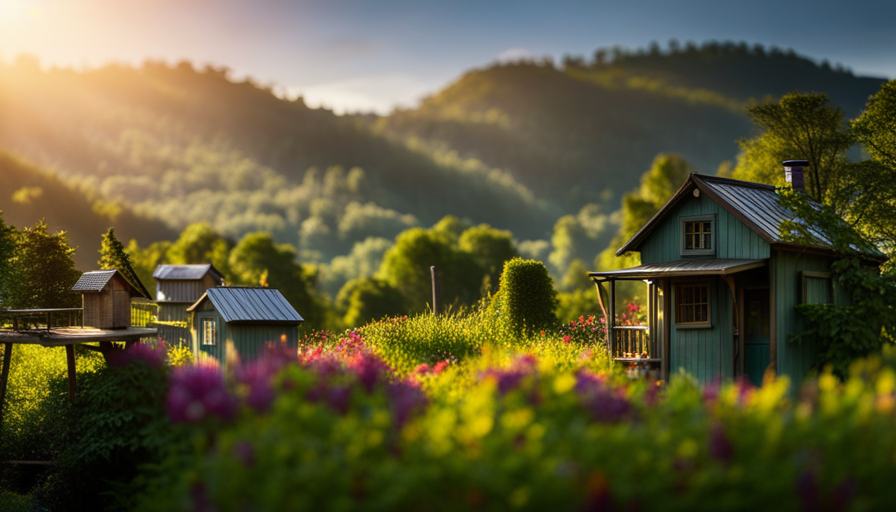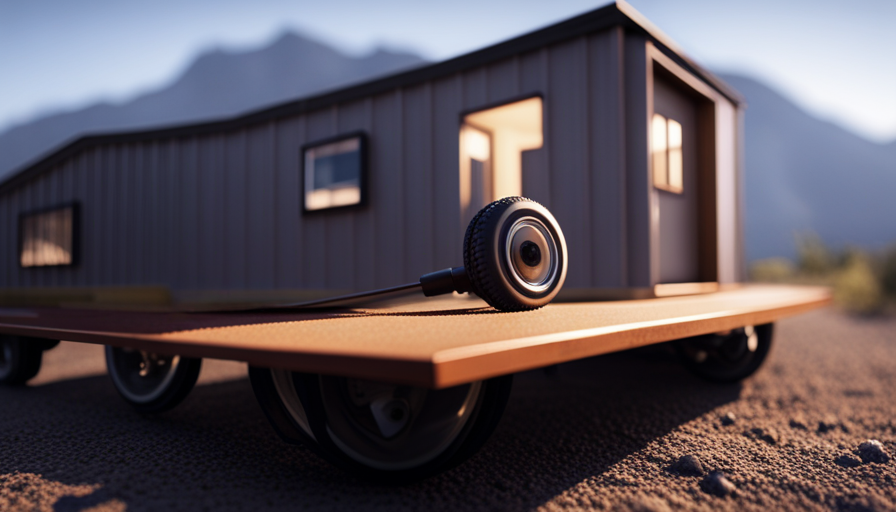Building a tiny house may seem like a daunting task, but with the right knowledge and skills, it can become a very rewarding project. While learning how to construct a small home may take some time and effort, it is definitely a journey worth embarking on.
In this article, I will guide you through the steps and timeline of how long it takes to learn to build a tiny house.
Becoming proficient in tiny house construction requires a solid foundation in the basics of construction, as well as a thorough understanding of the various systems that make up a home. From researching and gathering resources to enrolling in workshops or courses, every step is crucial in your learning journey. You will have the opportunity to practice essential skills such as framing and electrical work, and gain knowledge about plumbing and HVAC systems.
Seeking guidance from experts in the field is essential to ensure that you are on the right track and making progress. By setting realistic goals and prioritizing tasks, you can streamline the learning process and make efficient use of your time. Dedication to continuous learning is key, as building a tiny house is a skill that can always be improved upon.
So, let’s dive in and discover the timeline of learning to build a tiny house.
Key Takeaways
- Learning to build a tiny house requires time, effort, and dedication.
- Researching, gathering resources, and enrolling in workshops or courses are crucial steps in the learning process.
- Understanding construction techniques and building materials is essential.
- Seeking guidance from experts and setting realistic goals is important.
Understand the Basics of Construction
Learning to build a tiny house doesn’t take as long as one might think, provided you grasp the fundamentals of construction. Understanding construction techniques and building materials is essential to successfully completing a tiny house project. Construction techniques encompass a wide range of skills, such as framing, roofing, electrical work, and plumbing. It is important to learn the proper methods for each step of the building process to ensure structural integrity and safety.
Familiarizing yourself with different types of building materials, such as lumber, insulation, and siding, is also crucial in order to make informed decisions during the construction process.
To begin, it is essential to have a solid understanding of framing. This involves constructing the basic structure of the tiny house, including the walls, floors, and roof. Proper framing techniques ensure that the house is sturdy and able to withstand various weather conditions.
Additionally, learning about electrical work and plumbing is vital for installing necessary systems in the tiny house. This includes understanding wiring, outlets, switches, and plumbing fixtures.
Finally, knowing about different building materials will help you make informed decisions about which materials to use in your tiny house project.
Once you have a firm grasp on the basics of construction, it is time to move on to the next step: researching and gathering resources.
Research and Gather Resources
While researching and gathering resources, you’ll find a wealth of information to aid in constructing your compact dwelling.
One crucial aspect is finding the right location for your tiny house. Consider local zoning laws and regulations to ensure your tiny house will be allowed in the desired area. Additionally, assess the availability of utilities such as water, electricity, and sewage connections. It’s also important to consider the overall accessibility and convenience of the location.
Another key factor to consider during this phase is budgeting and financing options. Determine how much you’re willing to spend on your tiny house project and explore different financing options, such as personal loans or crowdfunding platforms. Researching cost estimates for materials and labor will also help you create a realistic budget.
In your search for resources, utilize online platforms, books, and documentaries that provide in-depth information about tiny house construction. Join online forums and social media groups where you can connect with experienced tiny house builders and enthusiasts who can offer valuable insights and advice.
Transitioning into the subsequent section about enrolling in a building workshop or course, it’s essential to have a solid foundation of knowledge and resources before embarking on the construction journey.
Enroll in a Building Workshop or Course
By enrolling in a building workshop or course, you can gain valuable expertise and hands-on experience necessary to turn your small dream home into a reality. These workshops and courses provide a structured and immersive learning environment that allows you to learn from experienced professionals in the field of construction.
Here are some benefits of enrolling in a building workshop or construction course:
-
Access to expert knowledge and guidance: The instructors in these workshops and courses have years of experience in the construction industry. They can teach you the essential skills and techniques needed to build a tiny house efficiently and safely.
-
Hands-on experience: Building workshops and courses provide you with practical experience. You get to work with real tools and materials, allowing you to gain confidence in using them effectively.
-
Networking opportunities: These workshops and courses often attract like-minded individuals who share your passion for building. This provides an excellent opportunity to connect with others, share ideas, and potentially find future collaborators or mentors.
-
Troubleshooting and problem-solving: In a building workshop or course, you will encounter various challenges and obstacles that you may face when building your tiny house. The instructors can guide you through these hurdles and teach you effective problem-solving techniques.
By enrolling in a building workshop or course, you not only learn the necessary skills but also gain the confidence and knowledge needed to practice essential skills such as framing and electrical work in the subsequent section.
Practice Essential Skills such as Framing and Electrical Work
Enrolling in a building workshop or course allows you to practice essential skills, such as framing and electrical work, in a structured and immersive learning environment.
When it comes to framing techniques, these courses provide hands-on experience with various methods, including platform and balloon framing. You’ll learn how to measure, cut, and assemble the structural skeleton of a tiny house, ensuring its stability and durability.
Additionally, these workshops emphasize the importance of electrical safety. You’ll gain knowledge about electrical codes, wire sizing, and grounding techniques. Hands-on practice will be provided, allowing you to safely install electrical outlets, switches, and light fixtures. Understanding the principles of electrical safety is crucial to prevent hazards and ensure a functional electrical system in your tiny house.
By enrolling in a building workshop or course, you’ll gain valuable knowledge and skills that are essential for constructing a tiny house.
In the subsequent section about learning plumbing and HVAC systems, you’ll expand your expertise in the necessary systems required for a comfortable and functional living space.
Learn about Plumbing and HVAC Systems
Learning about plumbing and HVAC systems is like exploring the intricate pathways and hidden networks that breathe life into a home, ensuring a comfortable and well-functioning living space. When it comes to building a tiny house, understanding plumbing and HVAC installation is crucial.
Plumbing involves the installation of water supply, drainage, and sewage systems. It requires knowledge of pipe materials, fittings, and fixtures. Additionally, learning about HVAC systems is essential for maintaining optimal temperature, ventilation, and air quality inside the tiny house.
To become proficient in plumbing and HVAC installation, it’s important to learn the basics of pipe sizing, water pressure regulation, and drainage slope calculations. Troubleshooting common plumbing issues such as leaks, clogs, and low water pressure is also necessary. Similarly, understanding HVAC systems involves learning about air conditioning, heating, and ventilation units, as well as ductwork and air filtration.
Gaining hands-on experience through projects is invaluable for mastering plumbing and HVAC skills. By working on real-life scenarios, like installing plumbing fixtures or troubleshooting HVAC problems, you can develop a deeper understanding of the systems. This practical experience will not only enhance technical knowledge but also build confidence in tackling future plumbing and HVAC challenges.
Transitioning into the subsequent section about gaining experience through hands-on projects, it becomes evident that practice is key to becoming proficient in building a tiny house.
Gain Experience through Hands-on Projects
Embarking on hands-on projects is like diving headfirst into a whirlpool of knowledge, where one can uncover the hidden depths of plumbing and HVAC systems. Gaining practical skills becomes second nature as one learns to navigate the intricacies of these essential systems.
Through hands-on projects, individuals have the opportunity to work with real plumbing and HVAC components, gaining firsthand experience in their installation and maintenance. Learning from mistakes is an integral part of the process, as it allows for a deeper understanding of the systems and their inner workings.
To truly grasp the complexities of plumbing and HVAC systems, here are five crucial aspects to focus on:
- Mastering pipe installation techniques: Understanding the correct methods for joining, cutting, and fitting pipes is essential for seamless plumbing systems.
- Becoming proficient in system troubleshooting: Learning how to identify and fix common issues, such as leaks or clogs, will ensure efficient operation.
- Acquiring knowledge of HVAC unit installation: Properly installing heating, ventilation, and air conditioning units guarantees optimal performance.
- Familiarizing oneself with electrical connections: Understanding the electrical aspects of these systems is vital for safety and functionality.
- Developing proficiency in system maintenance: Regular maintenance helps prevent costly repairs and ensures longevity.
By gaining practical skills and learning from mistakes, individuals can confidently progress towards the next step of seeking guidance from experts in the field, who can further enhance their knowledge and skills.
Seek Guidance from Experts in the Field
Seeking guidance from experts in the field is like unlocking a treasure trove of knowledge and experience, where seasoned professionals generously share their wisdom and insights to help you navigate the intricate world of plumbing and HVAC systems. These experts have spent years honing their craft and have encountered numerous challenges along the way.
By tapping into their expertise, you can explore alternative methods and gain a deeper understanding of the best practices for building a tiny house.
One of the greatest benefits of seeking guidance from experts is the opportunity to learn from their mistakes. They’ve likely encountered common pitfalls and can offer valuable advice on how to avoid them. For example, they can guide you on the most efficient ways to install plumbing and HVAC systems, ensuring that you don’t waste time and resources on trial and error.
Furthermore, experts can introduce you to innovative techniques and materials that may not be widely known. They can share their experiences with different construction methods and help you make informed decisions.
Seeking guidance from experts is an invaluable resource when learning to build a tiny house. Their knowledge and experience can save you time, money, and frustration. By learning from their mistakes and exploring alternative methods, you can set realistic goals and prioritize tasks effectively, which will be discussed in the subsequent section.
Set Realistic Goals and Prioritize Tasks
To achieve success in building your tiny house, it’s crucial to set realistic goals and prioritize tasks, ensuring you don’t bite off more than you can chew and end up overwhelmed. One way to do this is by creating a detailed plan and breaking down the construction process into manageable steps. By setting achievable milestones, you can stay motivated and track your progress.
| Tasks | Timeline | Budget |
|---|---|---|
| Research and Design | 1-2 weeks | $500 |
| Site Preparation | 1 week | $1,000 |
| Foundation and Framing | 2-3 weeks | $3,000 |
| Interior and Exterior Finishes | 3-4 weeks | $2,000 |
Setting a budget is another important aspect of building a tiny house. Determine how much you are willing to spend and allocate funds accordingly. This will help you make informed decisions and prevent overspending. Research the costs of materials, tools, and professional services to create a realistic budget. Remember to factor in unexpected expenses and leave some room for contingencies.
By setting realistic goals and managing your budget, you can stay on track and motivated throughout the building process. However, it’s important to remember that building a tiny house requires dedication and continuous learning. Transitioning into the next section, dedicating time and effort to continuous learning will further enhance your skills and ensure a successful outcome.
Dedicate Time and Effort to Continuous Learning
Investing time and effort in continuous learning will allow you to further enhance your skills and ensure a successful outcome in constructing your compact dwelling. As you embark on the journey of building a tiny house, continuous improvement is key. Here are three important aspects to consider for your continuous learning:
-
Stay Updated with Industry Trends: Follow blogs, attend workshops, and join online communities to stay informed about the latest techniques and materials used in tiny house construction. This will help you incorporate innovative ideas into your project and ensure that your tiny house is up to date with the latest trends.
-
Time Management: Building a tiny house requires careful planning and efficient time management. Set specific goals and allocate dedicated time for learning new skills and techniques. By prioritizing your tasks and managing your time effectively, you’ll be able to make consistent progress in your construction journey.
-
Seek Feedback and Learn from Mistakes: Actively seek feedback from experienced builders and fellow enthusiasts. Embrace constructive criticism and learn from your mistakes. This continuous feedback loop will allow you to refine your skills and improve the quality of your work.
By continuously improving your skills and managing your time effectively, you’ll be well on your way to successfully constructing your tiny house. Celebrate your progress and enjoy the journey as you move towards the next section about ‘celebrate your progress and enjoy the journey’ without writing ‘step’.
Celebrate Your Progress and Enjoy the Journey
Don’t forget to savor the moments and appreciate the progress you’ve made as you embark on the exciting journey of creating your compact dream home.
Finding inspiration is an important aspect of building a tiny house. With countless designs, styles, and innovations available, it’s crucial to explore various sources to fuel your creativity. Browse through books, magazines, and online platforms dedicated to tiny house construction. Attend workshops or join online communities where you can connect with fellow enthusiasts and gain valuable insights.
However, it’s essential to remember that challenges are inevitable during the construction process. Overcoming these obstacles will test your problem-solving skills and determination. From obtaining necessary permits to sourcing sustainable materials, each hurdle offers a learning opportunity. Embrace these challenges as chances to grow and expand your knowledge.
As you celebrate your progress, take the time to appreciate the journey itself. Building a tiny house is a labor of love and dedication. Cherish the moments of triumph, whether it’s successfully installing solar panels or crafting a custom storage solution. Remember, the joy lies not only in the end result but also in the process of bringing your vision to life.
So, take a step back, admire your accomplishments, and let the journey of building a tiny house fill you with pride and satisfaction.
Frequently Asked Questions
How much does it cost to build a tiny house?
To investigate the truth of the theory, let’s discuss the cost estimation and financing options for building a tiny house.
The cost of building a tiny house can vary greatly depending on factors such as size, materials, and location. On average, it can cost anywhere from $20,000 to $150,000.
Financing options for tiny house construction include personal savings, loans, and crowdfunding.
Proper research and budgeting are essential to ensure a successful and affordable tiny house build.
What are the legal requirements for building a tiny house?
When building a tiny house, it’s important to be aware of the legal requirements and zoning restrictions. Legal requirements vary depending on the location and can include obtaining building permits, adhering to safety codes, and meeting certain design standards.
Zoning restrictions may dictate the size, location, and use of the tiny house. It’s crucial to research and comply with these regulations to ensure a smooth and legal construction process.
Can I build a tiny house on my own without any prior construction experience?
Building a tiny house on your own without any prior construction experience? It may seem daunting, but it is possible. However, it requires certain skills. You need to be familiar with basic carpentry, plumbing, and electrical work. Additionally, understanding the principles of structural integrity and building codes is crucial.
While it may take time to acquire these skills, with dedication and the right resources, you can successfully build a tiny house on your own.
How long does it take to build a tiny house from start to finish?
From start to finish, the time it takes to build a tiny house depends on various factors, including time management and the availability of building materials. Efficiently managing your time and having all the necessary materials ready can expedite the construction process. However, on average, it can take anywhere from a few weeks to several months to complete a tiny house.
It’s important to plan and allocate enough time for each step of the construction process to ensure a successful outcome.
Are there any specific building codes or regulations I need to follow when constructing a tiny house?
When constructing a tiny house, it’s crucial to adhere to specific building codes and regulations. These regulations vary depending on your location, so it’s important to research and understand the requirements in your area. Building codes for tiny houses typically cover aspects such as size limitations, safety standards, electrical and plumbing systems, and zoning regulations. Familiarizing yourself with these regulations will ensure that your tiny house construction meets legal requirements and maintains a safe and functional living space.
Conclusion
In conclusion, building a tiny house is a rewarding and fulfilling journey that requires dedication and continuous learning. By understanding the basics of construction, researching and gathering resources, enrolling in workshops or courses, practicing essential skills, and seeking guidance from experts, you can acquire the knowledge and skills needed to build your own tiny house.
Remember to set realistic goals, prioritize tasks, and dedicate time and effort to your project. And as you progress, take a moment to ask yourself: "Can you imagine the satisfaction of living in a home you built with your own hands?" "Can you imagine the satisfaction of living in a home you built with your own hands? It is a testament to your determination, creativity, and resourcefulness, and a constant reminder of your ability to turn dreams into reality."
Hi, I’m Emma. I’m the Editor in Chief of Tiny House 43, a blog all about tiny houses. While tree houses are often associated with childhood, they can be the perfect adult retreat. They offer a cozy space to relax and unwind, surrounded by nature. And since they’re typically built on stilts or raised platforms, they offer stunning views that traditional homes simply can’t match. If you’re looking for a unique and romantic getaway, a tree house tiny house might just be the perfect option.










